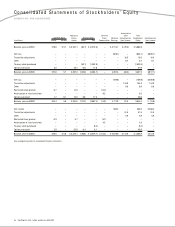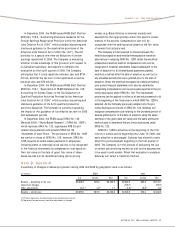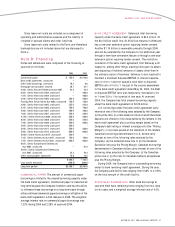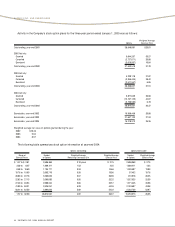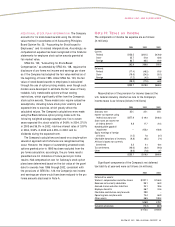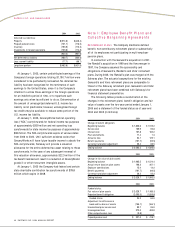Safeway 2004 Annual Report Download - page 40
Download and view the complete annual report
Please find page 40 of the 2004 Safeway annual report below. You can navigate through the pages in the report by either clicking on the pages listed below, or by using the keyword search tool below to find specific information within the annual report.
SAFEWAY INC. AND SUBSIDIARIES
Fair value is determined by estimating net future cash flows,
discounted using a risk-adjusted rate of return. The Company
calculates impairment on a store-by-store basis. These
provisions are recorded as a component of operating and
administrative expense and are disclosed in Note C.
For stores to be closed that are under long-term leases,
the Company records a liability for the future minimum lease
payments and related ancillary costs, from the date of closure
to the end of the remaining lease term, net of estimated
cost recoveries that may be achieved through subletting
properties or through favorable lease terminations, discounted
using a risk-adjusted rate of interest. This liability is
recorded at the time the store is closed. Activity included in
the reserve for store lease exit costs is disclosed in Note C.
STOCK-BASED COMPENSATION Safeway accounts for
stock-based awards to employees using the intrinsic value
method in accordance with Accounting Principles Board
Opinion (“APB”) No. 25, “Accounting for Stock Issued to
Employees.” The following table illustrates the effect on net
income (loss) and earnings (loss) per share if the Company
had applied the fair value recognition provisions of SFAS
No. 123, as amended by SFAS No. 148:
(In millions, except per-share amounts) 2004 2003 2002
Net income (loss) – as reported $560.2 $(169.8) $(828.1)
Add:
Stock-based employee
compensation expense included
in reported net income, net of
related tax effects 2.8 0.1 –
Less:
Total stock-based employee
compensation expense
determined under fair value
based method for all awards,
net of related tax effects (47.6) (51.2) (49.6)
Net income (loss) – pro forma $515.4 $(220.9) $(877.7)
Basic earnings (loss) per share:
As reported $1.26 $(0.38) $(1.77)
Pro forma 1.16 (0.50) (1.88)
Diluted earnings (loss) per share:
As reported $1.25 $(0.38) $(1.77)
Pro forma 1.15 (0.50) (1.88)
NEW ACCOUNTING STANDARDS In December 2003, the
FASB revised SFAS No. 132, “Employer’s Disclosures about
Pensions and Other Postretirement Benefits.” This revised
statement requires new annual disclosures about the types
of plan assets, investment strategy, measurement date, plan
obligations and cash flows as well as components of the
net periodic benefit cost recognized in interim periods. The
new annual disclosure requirements apply to fiscal years
ending after December 15, 2003, except for the disclosure
of expected future benefit payment, which must be
disclosed for fiscal years ending after June 15, 2004.
Interim period disclosures are generally effective for interim
periods beginning after December 15, 2003. The Company
has included the disclosures required by SFAS No. 132 in its
financial statements for the year ended January 1, 2005.
In January 2004, the FASB issued SFAS No. 106-1,
“Accounting and Disclosure Requirements Related to the
Medicare Prescription Drug, Improvement and Modernization
Act of 2003.” This statement permits a sponsor to make a
one-time election to defer accounting for the effects of the
Medicare Prescription Drug, Improvement and Modernization
Act of 2003, or the Prescription Drug Act. The Prescription
Drug Act, signed into law in December 2003, establishes a
prescription drug benefit under Medicare (Medicare Part D)
and a federal subsidy to sponsors of retiree health care
benefit plans that provide a benefit that is at least actuarially
equivalent to Medicare Part D. SFAS No. 106-1 does not
provide specific guidance as to whether a sponsor should
recognize the effects of the Prescription Drug Act in its
financial statements. The Prescription Drug Act introduces
two new features to Medicare that must be considered when
measuring accumulated postretirement benefit costs. The
new features include a subsidy to the plan sponsors that is
based on 28% of an individual beneficiary’s annual
prescription drug costs between $250 and $5,000 and an
opportunity for a retiree to obtain a prescription drug benefit
under Medicare. The Prescription Drug Act is not expected to
reduce Safeway’s net postretirement benefit costs.
Safeway has elected to defer adoption of SFAS No. 106-1
due to the lack of specific guidance. Therefore, the net
postretirement benefit costs disclosed in the Company’s
financial statements do not reflect the impacts of the
Prescription Drug Act on the plans. The deferral will continue
to apply until specific authoritative accounting guidance for
the federal subsidy is issued. Authoritative guidance on the
accounting for the federal subsidy is pending and, when
issued, could require information previously reported in the
Company’s financial statements to change. Safeway is
currently investigating the impacts of SFAS No. 106-1’s
initial recognition, measurement and disclosure provisions
on its financial statements.
38 SAFEWAY INC. 2004 ANNUAL REPORT








